Fighting to defeat the Confederacy, the first African American regiments also helped win for themselves the full rights and privileges of U.S. citizens.
-
Spring 2021
Volume66Issue3
Editor's Note: Douglas R. Egerton is Professor of History at LeMoyne College. The following essay was adapted from his Gilder Lehrman Lincoln Prize-winning book, Thunder at the Gates: The Black Civil War Regiments That Redeemed America, published by Basic Books.
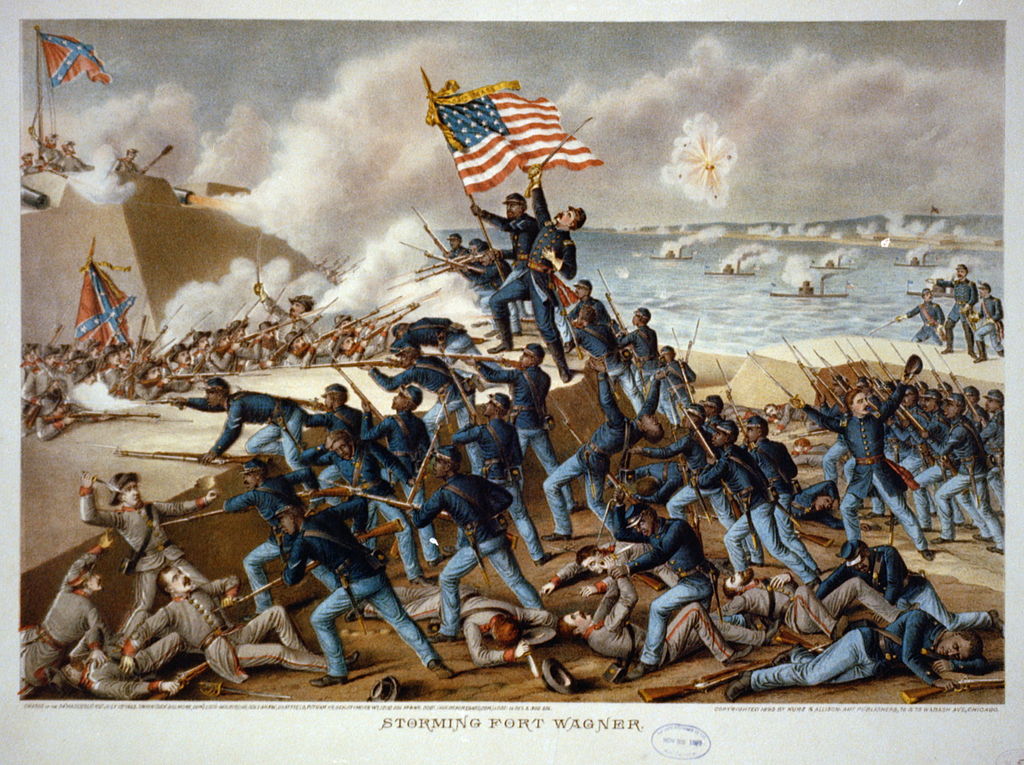
Weary after the long march, the black infantrymen fell to their knees, dropping their muskets and pulling off their heavy gear. Their white colonel, twenty-eight-year-old Alfred Hartwell, a Massachusetts native and a Harvard man, consulted his hand-drawn map and guessed them to be on the outskirts of Pineville, a South Carolina village of roughly 100 buildings.
That morning, April 3, 1865, Hartwell had received orders to take a detachment of the Massachusetts Fifty-fifth Volunteer Infantry Regiment and head upland toward Lake Moultrie in search of Confederate cavalry. After firing a few shots at a mounted party riding in advance of Hartwell's infantry, the Confederates vanished, but not before lynching a number of runaway slaves they found hiding in a swamp. The discovery of the bodies brought the soldiers to their feet, and by the time they reached the gates of a plantation owned by Charles Porcher, the company was in no mood to be charitable to those yet loyal to the collapsing Confederacy.
Although Hartwell's orders merely called for the Fifty-fifth to search for remaining Confederate forces in the interior, the black soldiers gloried in serving the cause of liberation. Months before, Sergeant James Monroe Trotter had observed that “we found the old system of slavery in full operations as it had always been.” As they overran Carolina plantations Hartwell demanded that soon-to-be former masters “blow their horns, to summon the slaves from their work up to the house.” An officer—typically a black sergeant—then made a speech, “informing them they were free.”
There was “joy on those plantations, I need not tell you,” Lieutenant George Garrison informed his father, abolitionist William Lloyd Garrison. Trotter would explain to the freed people that they could leave for Charleston if they wished, but that if they planned to remain on the estate, the army would assist in drawing up a written agreement to compensate for labor done.”
A former slave himself who had taught school in the Midwest before the war, Trotter understood all too well that it was not just Southern whites who despised the idea of a black man with stripes on his uniform, or even a black man in uniform. For two years, the Fifty-fourth and Fifty-fifth—and now the first Northern black cavalry regiment, the Massachusetts Fifth—had battled Northern racism when not assaulting impregnable Confederate fortifications. The nearly 5,000 men who served in the three regiments recognized that the problems facing the nation were not all the result of secession.
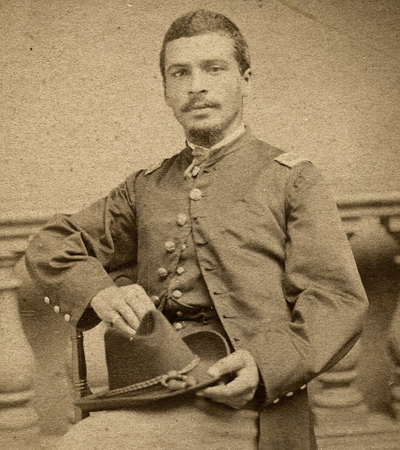
Most of the recruits hailed from states that denied them the right to vote, banned their children from public schools, and allowed thugs to beat them when they boarded streetcars and trains. Trotter and his fellows had signed on to crush the Confederacy and put an end to the enslavement of 4 million blacks, but also to win for themselves the full rights and privileges of American citizens.
Those who enlisted in early 1863 understood that it was by no means certain that their sacrifice would convince white Americans to accept their claims. A good many Northern freemen had fathers or uncles who had served in previous wars. Roughly 5,000 black men had joined the Patriots during the Revolution, but significantly, those soldiers disproportionately hailed from those New England states that were home to few African Americans overall. (Another 15,000 Africans and African Americans, mostly from the South, sided with the Loyalists as the best path to freedom.) Only Massachusetts permitted slaves to volunteer in exchange for their freedom, and many, such as Peter Salem, fought at both Concord and Bunker Hill. Several other Northern states allowed bond men to enlist as substitutes for their masters, which typically resulted in freedom—provided they survived the fighting.
Black veterans had prayed that the Revolution might offer not merely new opportunities for freedom but also full participation in the new political order. When Massachusetts crafted its new state constitution in 1780—even before slavery was abolished in the state—it rewarded black veterans by allowing all freedmen the right to vote. Slavery in the North collapsed fastest in those states that had lower proportions of blacks, but also in those that had high numbers of black veterans, who often returned from the war armed and prepared to liberate wives and children and to sue for political rights when necessary. Now their sons hoped to force an unwilling nation to finally recognize those rights.
Because of that recent history, from the moment the first black man enlisted, Northern Democrats feared the obvious connection between military service and future demands for federal citizenship. “The only motive for adopting the black soldier system was the fanatical idea of negro equality,” fumed a New York publisher, “and the determination of the radicals to do everything possible to raise the negro to the social and political level of the white." Despite disastrous setbacks for the U.S. Army at both battles of Bull Run, the Peninsula Campaign, and again in December 1862 at Fredericksburg, most Democrats appeared to prefer an endless bloodbath to the prospect of black voting rights.
So worried was the Lincoln administration about appeasing Northern racists that it was not until the Emancipation Proclamation went into effect in January 1863 that his War Department permitted Massachusetts governor John A. Andrew to begin raising black regiments. As abolitionist Frederick Douglass spoke across the North in favor of Andrew's proposal, the vitriol reached ugly new lows. “Fred Douglass sounds the war cry to the darkeys of New York,” sneered a Cleveland editor. “Let us imagine Fred standing on an eminence near Rochester, a perfume bottle in one hand,” speaking to the black recruits, as “the swords of the charcoal officers protrude between their legs like monkey's tails.”
That Douglass, born a slave in Maryland, had become a respected, elegantly dressed, and eloquent antislavery orator clearly outraged the Ohio publisher, but perhaps his real fear was that black soldiers would aim “their muskets North, South, East and West” and not merely at the Confederate military.
In early 1863, virtually all Americans—white and black, Confederate and Unionist, Republican and Democrat—understood that the three black regiments were to serve as a test case. Irregular efforts were then under way in Kansas and along the Carolina coast to arm blacks, but those actions were far from the public's gaze and largely unwelcome to the War Department. Instead, the eyes of the United States were on Massachusetts. Should its soldiers succeed and fight brilliantly, that would open the door for other Northern states to begin recruiting African Americans and for the federal government to place blue uniforms on runaways and refugees in Washington and the border states. Should they live down to the dismal expectations of conservative Democrats, white soldiers, and more than a few moderate Republicans, that performance would not only put an end to the experiment but set off repercussions for American society for generations to come.
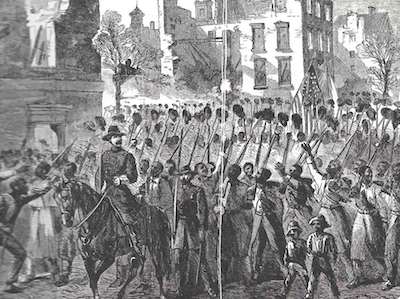
As the first black regiments to be raised in the free states, as well as the first to enjoy any visibility among the press and Northern politicians, the Massachusetts units justifiably believed that had they faltered in their first test, the tens of thousands of black recruits who followed would have been barred from service. By the war's end, 178,975 African Americans, constituting one-twelfth of all the soldiers who fought for the United States, had filled 145 infantry regiments, seven cavalry units, 13 artillery groups, and one engineering battalion.
An astonishing 74 percent of Northern black men of military age enlisted to fight for a nation that denied them citizenship. Of the total number of enlistees, however, 140,313 were Southerners recruited either in the loyal slave states or from the Confederacy. James Henry Gooding was among the 2,751 blacks killed; in far more, 65,427, died of disease or went missing. “Only two short years have elapsed since stern, hard necessity, and the loyalty of the colored man, have led hundreds of thousands to strike hands with us, and God-speed,” remarked one soldier from the Fifty-fifth.
Fort Wagner “was their Bunker Hill,” Senator Charles Sumner remarked in December 1865. One of several batteries that guarded the Charleston harbor, the beachhead fortress was an impressive feat of engineering, built of packed sand and earth and boasting fourteen cannon. Some 2,600 yards south of Fort Sumter, the earthwork ran clear across the sandspit which forms the northern portion of Morris Island, and attacking troops had to approach head-on along a narrow neck of sand. It was believed that if all of the island could be taken, siege guns could be mounted so as to destroy Fort Sumter and other harbor defenses and clear the way for Union warships.
A preliminary attack failed, and a larger one was arranged for the night of July 18, 1863. Leading it was the Fifty-fourth, commanded by Colonel Robert Gould Shaw. But the battery was much more heavily manned than previously believed -- the enormous bombproof structure alone sheltered nearly 1,000 of the Confederate garrison’s 1,800 troops. In all, about 1,515 Union soldiers were killed, captured, or wounded in the assault, including Shaw.
The story of the Fifty-fourth, or at least the first few months of its history, has appeared in fiction and film, from Louisa May Alcott's “My Contraband,” a short story first published in late 1863, to the 1989 movie Glory. Because Bob, Alcott's fictional former slave, dies at Fort Wagner on July 18, 1863, in the regiment's second battle, her story concludes just as later recruits such as Trotter were arriving at Readville, Massachusetts, the site of the regiment's training. Alcott's tale might have formed the basis for the pervasive misconception that the saga of the earliest black troops ended only six months after enlistments first began.
Glory adheres to that truncated narrative, suggesting that the history of the Fifty-fourth concluded that July night on the parapets of Fort Wagner. Of the six main characters in the film, only Robert Gould Shaw actually existed. The other five are either composite characters or are so loosely based on real soldiers that the screenwriter gave them fictional names. Men who played central roles in the regiments, such as Frederick Douglass's sons Lewis and Charles, earn not so much as a cameo appearance.
In reality, while the assault on Wagner was a defining moment, a majority of the regiment fought on until the end of the war and even served as an occupying force in Charleston until the fall of 1865. Having enlisted less to preserve the Union than to win the peace, the men of the Fifty-fourth fought on in the years after Appomattox, either by renewing their prewar activism or by going into politics and serving in Southern state assemblies.
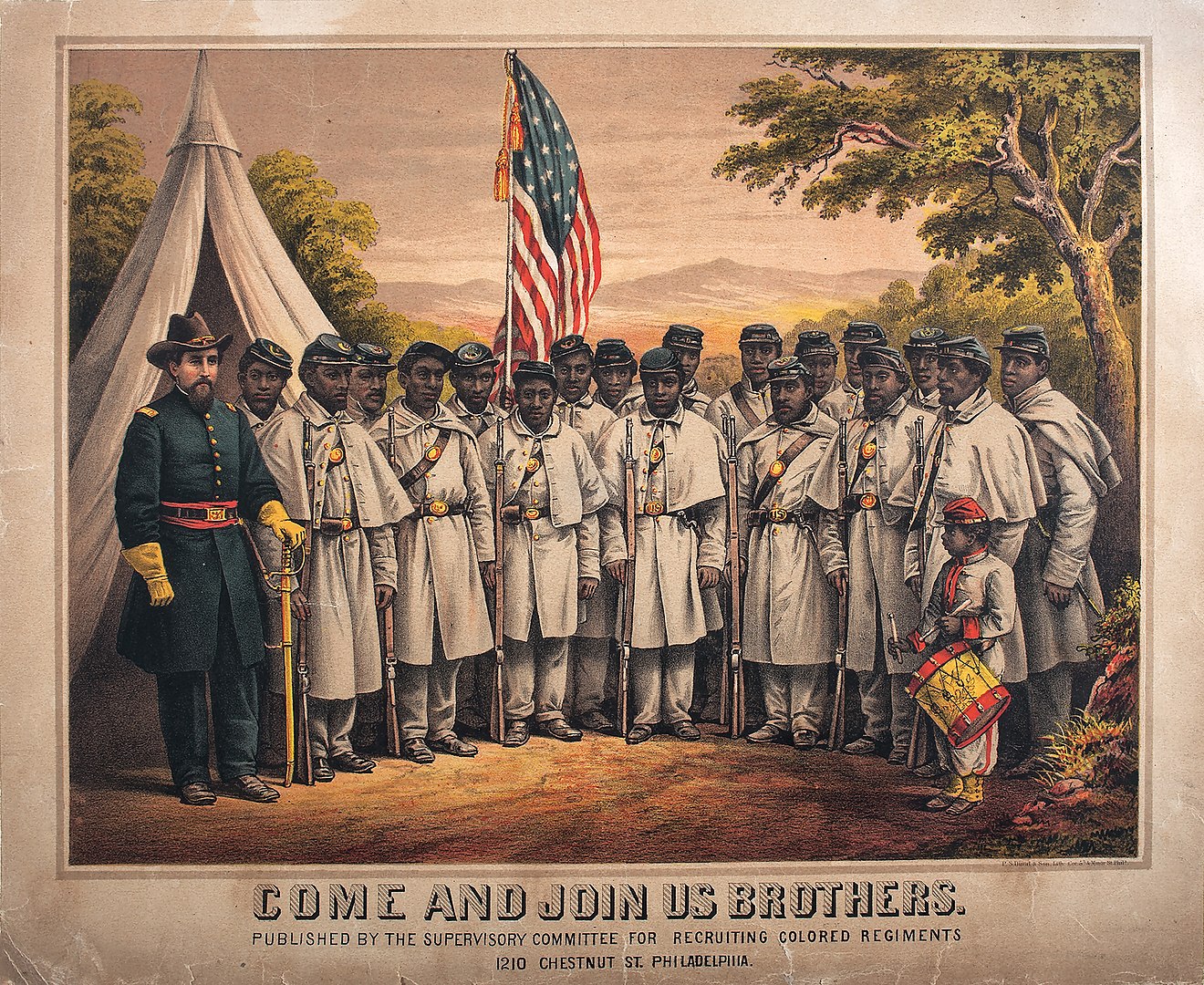
Indeed, “though defeated” in that July battle, “they were yet victorious," as “the cause was advanced.” Northern whites who had scoffed at the notion that black men could make effective combatants “learned to know colored troops, and they learned to know themselves,” and from that day on, “nobody doubted their capacity or courage as soldiers.” Pen Hallowell also dedicated many of his later writings to the proposition that the courage of the Massachusetts regiments had not merely opened the doors to thousands more black recruits but turned the tide against the Confederacy. “When we remember that Grant lost 60,000 men in 60 days, a number equal to Lee's effective army at that time, it well becomes a question worthy [of] the serious attention of the historian” what might have happened had not black soldiers been permitted to enlist.
Thomas Wentworth Higginson expressed similar thoughts when asked to comment on the view, so prevalent among Democratic officers, that “the chief obstacle” to black soldiers came from common soldiers. Rather than point a finger at Washington, as well he might have done, Higginson instead blamed “civilians at home.” But after the summer of 1863, he believed, nothing was “more remarkable than the facility with which the expected aversion of the army everywhere vanished before the admirable behavior of the colored troops.
In the days surrounding the event, Boston newspapers recounted the details of the assault on Wagner. But within one year, after Congress declared war with Spain over Cuba, it was almost as if white Americans had to be reminded once more of black valor during the previous conflict. In a replay of 1863, only Massachusetts and Ohio urged black men to enlist, while New York State, fumed one black journalist, took the position that "its Afro-Americans have no place in the national guard in politics, or in almost anything else.”
In Mobile, Alabama, white soldiers “tried to lynch a Negro in their camp.” As the editor of the black-owned Cleveland Gazette wondered, why must the nation be crippled by these old divisions when it should be fighting as a united country? “In our civil war 186,000 colored troops were enlisted,” the editor wrote, "and the conduct of the Fifty-fourth Massachusetts at the assault upon Fort Wagner, July 18. 1863, proved that the Negro, well led, makes a heroic soldier."
A century and a half after the three regiments were mustered out, the meaning of the war remains disputed, at least among the general public. So too does the legacy of the black units. In 2014, during the bicentennial of the February 1864 Battle of Olustee, the Florida chapter of the Sons of Union Veterans requested that the National Park Service (NPS) permit a monument to soldiers from the Fifty-fourth to stand beside the 1912 obelisk erected by the Daughters of the Confederacy. But the idea was condemned by the Sons of the Confederacy, and especially by Republican state assemblyman Dennis Baxley, who fretted that a marker honoring those black soldiers who fought in Florida to preserve the United States constituted “revisionist history.”
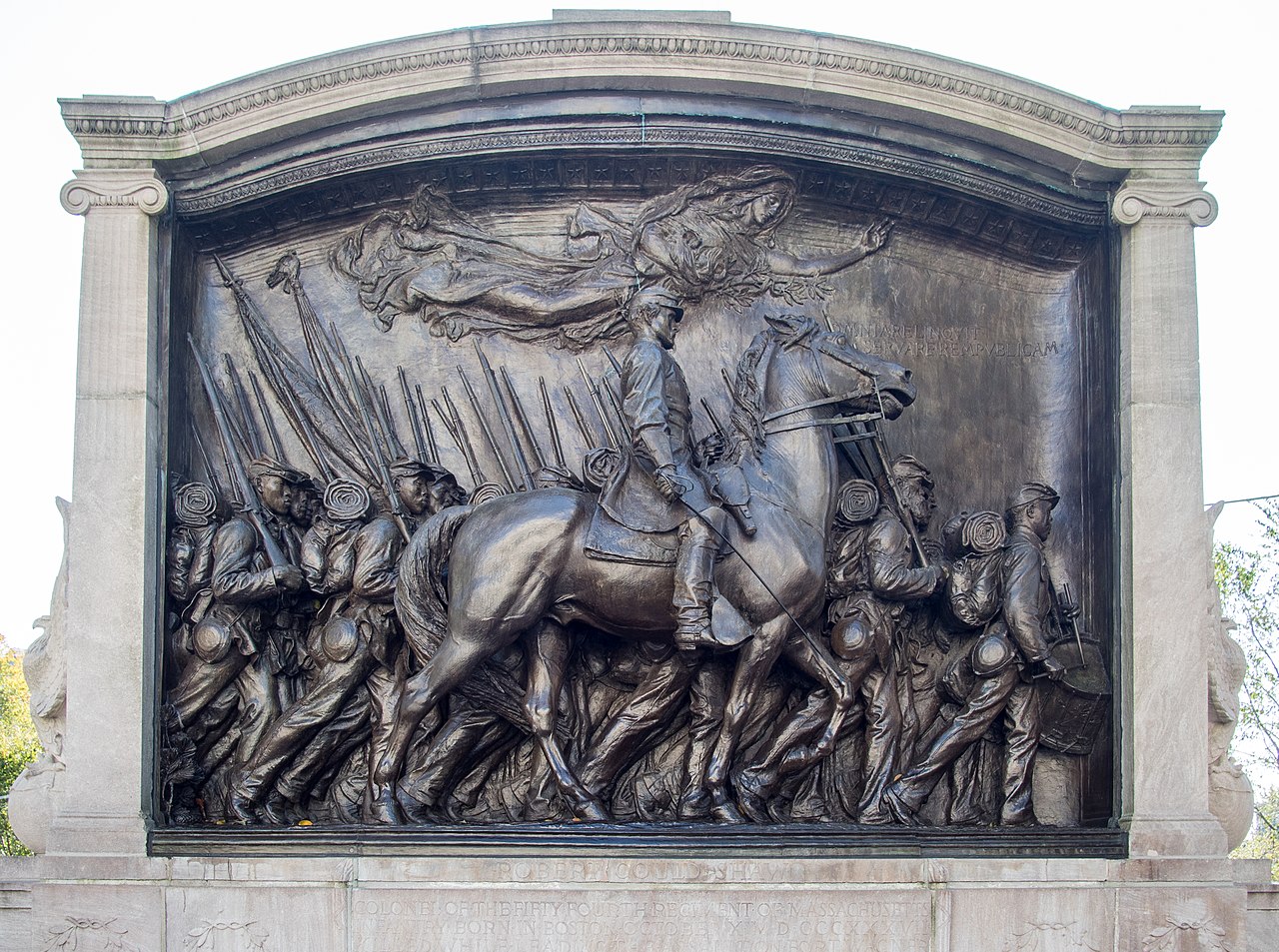
Michael Givens, the commander in-chief of the Sons of Confederate Veterans, added that a second marker "will disrupt the hallowed grown [sic] where Southern blood was spilled in defense of Florida,” a statement that ignored the complicated truth that North Carolina native James Henry Gooding, who was shot at Olustee, also shed “Southern blood” on that landscape.
Just over a year later, on June 17, 2015, a white vigilante opened fire in Charleston's historic Emanuel AME Church, killing nine congregants who had gathered for bible study and prayer. The killer had photographed himself holding a Confederate flag, and the murders set off another round of debates about the banner's meaning.
As Confederate flags began to come down across the South, Bostonians awoke on Monday, June 29, to find a Confederate battle flag hanging from the tip of Rob Shaw's sword on the Saint-Gaudens memorial. Passersby attempted to pull down the flag but only managed to shred it; a visitor from Lowell succeeded in untying it just before police arrived. “Such an expression of hate is not acceptable,” one Bostonian complained. “Obviously it's pretty upsetting to see,” observed another. “When somebody puts something in a spot like that, obviously they are trying to send a message, and it's an upsetting message.”
Silent and resolute, the bronze soldiers and the young colonel on horseback take no notice. They have seen worse, from the racism of the antebellum home front through the hard fighting of the war and into the dark days of Reconstruction-era Klan vigilantism. They stare straight ahead and continue their long march into history.

